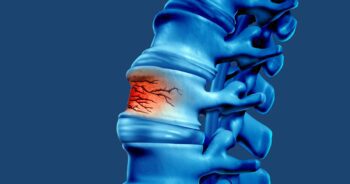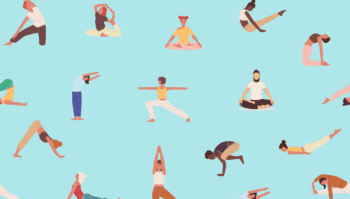Yoga as Therapeutic for Low Back Pain & Aquatic Possibilities
When practiced correctly, yoga appears to be effective in treating a wide variety of health conditions. Iyengar yoga is most commonly found in therapy as it strives for precise anatomical alignment and uses various props to assist positioning. The attention to precise anatomical positioning makes it well-suited to back pain, where dysfunctional alignment may be either contributing to or causing the problem. In the first randomized trial, evidence that Iyengar yoga can assist in alleviating chronic back pain involved sixty participants who were placed in either a yoga group or an educational group. Both programs lasted sixteen weeks. Participants had experienced low back pain for an average of 11.2 years and 48% used pain medication. At the end of the study and at a three-month follow-up, those in the yoga group had significant reductions in pain intensity, functional disability (including spinal range of motion), and use of pain medication. These results compare favorably with results obtained with traditional physical therapy.
A growing yoga division is yoga therapy. Yoga therapy can be used as a complement to traditional therapy and medicine. It is a holistic approach working the body, mind, and spirit and is distinct from traditional yoga classes commonly available. The addition of these elements and increased body awareness distinguish yoga from general stretching and callisthenic activity. Yoga links back pain to posture, muscle tightness, and muscle weakness, as well as to a lack of body awareness. Beyond abdominal crunches and tight hamstrings, many people have tight hip rotators in the pelvis and weak back extensors. The yogic approach is to determine which muscles need strengthening and which ones need stretching. Independent of the effect on individual muscles, asana (poses) movements help back pain by improving the circulation that brings nutrients to the intervertebral disks while removing toxins. The discs that cushion vertebrae and act as gelatinous shock absorbers do not have their own independent blood supply and depend on movement of the surrounding structures to aid in the delivery of nutrients. Movement causes the discs to compress, which squeezes out stale disk fluid, and then to expand, bringing a fresh supply. (McCall)
A review of literature on research addressing yoga and low back pain is land-based, but applicable to the water in many ways. A 1983-84 study at the London-based Yoga Biomedical Trust, run by Robin Monro, PhD surveyed 2,700 people between 31 and 60 who used yoga therapeutically. They were required to have practiced yoga for at least two hours a week for a year or longer. Of the 1,142 participants reporting, 98% of back-pain sufferers found yoga to be helpful. (McCall)
The Yoga Journal (May/June 2003) introduced a program launched “Back Builders” by Vijay Vad, MD, a specialist in sports medicine at the Hospital for Special Surgery in NY combining yoga, breath work, and Pilates. He theorized that lower back pain is really a mind-body problem, closely related to stress. All participants took the medications Celebrex and Vicodin. After six months, Vad found that 80% of those in the program experienced markedly decreased pain, compared with 44% on medication only. Only 12% of the yoga practitioners experienced another acute episode of their injury, compared with 56% of those on medications alone. Another significant result showed reduction in pain medication use of those doing yoga declined by 40%. The basic idea behind Back Builders is to build core strength and flexibility and lengthen the spine to create space between the vertebrae, thus minimizing pressure on the discs and allowing them to heal. The program eliminates potentially harmful poses such as sitting postures and forward bends which can compress the vertebrae of the lower spine. Program emphasizes asanas that build support for the spine by strengthening the abdominal and back muscles. Hip-opening poses encourage spinal length as do postures that stretch the hamstrings and calves. This has direct application to practice in the water because of the properties of water assist the specifics he addressed.
In the Annals of Internal Medicine (Dec. 2005), Loren Fishman, MD, specialist in back pain with a rehabilitation clinic in NYC and author of Relief Is in the Stretch: End Back Pain Through Yoga published a randomized, controlled clinical trial with low back pain that showed that not only did yoga work, but it worked so well that it surpassed even traditional physical therapy exercises.
Researcher Karen Sherman at the Group Health Cooperative in Seattle studied 101 adults suffering from chronic low back pain and randomly assigned them into three groups. One group attended weekly yoga classes for 12 weeks, following a therapeutic yoga routine developed specifically for lower back pain. Participants were expected to also practice at home every day. A second group attended a once a week program of stretching and strengthening exercises developed by a physical therapist with expected daily home practice. The third group received a self-care book that included some stretches and relaxation exercises. The yoga participants had less pain and were better able to go about their daily activities than people in either of the comparison groups. Follow-up at three months showed the yoga practitioners continued to have less pain and better function and needed fewer pain medications.
Reported in the International Journal of Yoga Therapy (2003), Kimberly Williams at the WVU School of Medicine compared effects of an adapted regimen of Iyengar yoga on patients with chronic low back pain to a group that received a weekly informational newsletter. 42 of 66 subjects completed the study. The yoga group attended 16 weekly classes. Compared to control subjects, the yoga group experienced a 64% reduction in pain, a 77 % reduction in “functional disability”, and a 25% improvement in perceived control over pain. They also gained significantly in hip flexibility. Those taking pain medication at the beginning of the study found 88% of the yoga group either reduced their dose or eliminated medication entirely as compared to 35% in the control group.
Elise Browning Miller has done extensive work with yoga and scoliosis. Scoliosis is classified as either structural or function. Structural is more serious than functional and develops as a result of unequal growth of the two sides of the vertebral bodies and usually appears during adolescence. Functional scoliosis is more common and affects the muscular back. It does not alter the body structurally and can result from poor posture or repeated unbalanced activity such as carrying heavy objects always on one side. In yoga for scoliosis, the goal is to stretch muscles that have tightened and strengthen muscles that have become weak from asymmetrical imbalance.
Examining yoga poses that are most often included in therapeutic land yoga that transfer to the pool, we find some direct correlations. Supporting the proposal of aquatic yoga, we recognize that poses have a calming effect on the nervous system and help to alleviate stress. They can facilitate harmony between the muscular and nervous systems of the body, possibly resulting in fluid movement and relief from muscle tension. The buoyancy of the water enables many to continue an exercise program in a supportive, positive environment resulting in improved coordination and balance, increased flexibility and strength, and an overall feeling of well-being.
General benefits of aquatic yoga include increased flexibility and balance, increased range of motion in the joints, improved muscle tone, and isometrically work most of the body’s muscle groups. The range of motion in these poses is adjusted to the ability of the patient on the particular day. Holding the pose not only challenges balance but requires moderate strength through correct body alignment and awareness and cognitive attention to the posture’s position to enhance key areas relating to activities of daily living.
Poses moved to the water can begin at the wall for support and moved to chest depth water when lumbar stability is proven. Some can be incorporated into Pilates exercises.
Cross-over Stretch
On your back on land or against the pool wall, pull the right knee toward the chest. Keep both shoulders grounded while using the left hand to assist the right bent leg across the body. Right arm is extended to the side
Chair (Utkatasana)
From the front standing position, feet hip-width apart and pretending to sit in a chair, squat position. Begin with extending arms forward and progress to extending arms in line with ears. Maintain a flat back.
Eye of Needle
Sitting in chair position against pool side, left foot stays on the pool bottom. Right ankle crosses to top of left knee. Assist stress by applying pressure on right thigh. Repeat on the opposite side. (Hip replacement caution.)
Tree (Vrkasana)
Begin with knee to the front and open to side. Arm position progresses as balance improves. Problems include lack of gluteus contraction, hip juts to side/hip hike, and forward or downward looking head position.
Spinal Rotation (Marichyasana)
Stand facing the side of the pool. Cross one leg over the other and rotate from the waist to look behind you toward the side with the leg in front. Shoulders stay level. Axial elongation and cervical rotation assists with releasing pressure on spine. Chin up remains up.
Mary O. Wykle, PhD, is on the Advisory Board of Aqualogix Fitness and is a Spinal Champion®.



